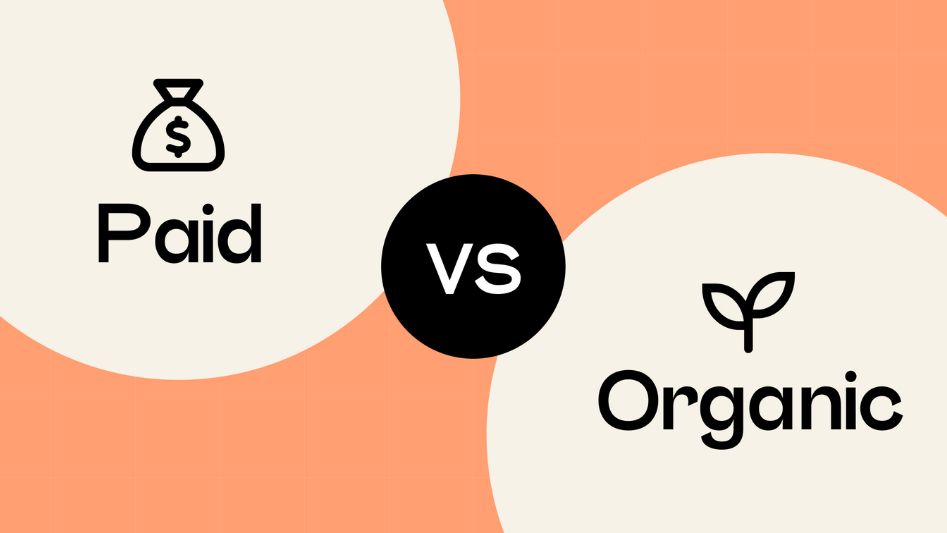In the digital marketing landscape, businesses are constantly striving to maximize their online visibility and attract their target audience. Two common strategies for achieving this are paid advertising and organic reach. Paid advertising involves investing money in promotional campaigns, while organic reach focuses on generating traffic naturally through search engine optimization (SEO) techniques and quality content. Both approaches have their merits, but finding the perfect balance between them is crucial for a successful marketing strategy. In this article, we will explore the nuances of paid advertising and organic reach, their advantages and disadvantages, and how businesses can strike the right balance to optimize their online presence.
Table of Contents:
We invite you to read: “Get Noticed, Get Results: Paid Advertising Tips and Tricks for Success”

Paid Advertising: Reaching the Right Audience
Paid advertising is an effective method to quickly gain visibility and reach a targeted audience. With platforms like Google Ads and social media advertising, businesses can create highly targeted campaigns based on demographics, interests, and user behavior. This level of precision allows businesses to connect with potential customers who are more likely to convert.
The Benefits of Paid Advertising
Paid advertising offers several benefits for businesses aiming to increase their online visibility:
- Immediate Results: Unlike organic reach, which takes time to build momentum, paid advertising delivers immediate results. With a well-crafted ad campaign, businesses can start attracting visitors and generating leads almost instantly.
- Targeted Reach: Paid advertising provides granular targeting options. Businesses can define their ideal audience based on demographics, interests, online behavior, and other relevant factors. This precision ensures that the ad reaches the right people, maximizing the chances of conversion.
- Measurable Performance: With paid advertising, businesses can track and measure their campaigns’ performance in real-time. Analytics tools offer valuable insights into impressions, clicks, conversions, and other key performance indicators (KPIs). This data allows businesses to refine their strategies and optimize their return on investment (ROI).
The Drawbacks of Paid Advertising
While paid advertising can yield impressive results, it also has some limitations that businesses should consider:
- Cost: Paid advertising requires a financial investment. Businesses need to allocate a budget for ad campaigns, and costs can quickly add up, especially for competitive keywords and popular platforms. It’s crucial to manage the budget effectively and continuously evaluate the ROI to ensure the ads are generating a positive outcome.
- Ad Fatigue: With the abundance of online ads, consumers have become desensitized and often overlook or ignore them. This phenomenon, known as “ad fatigue,” can reduce the effectiveness of paid advertising campaigns. To combat this, businesses must create compelling and engaging ads that capture the audience’s attention.
- Limited Long-Term Impact: Unlike organic reach strategies, which have the potential to generate ongoing traffic and visibility, paid advertising’s impact is limited to the duration of the campaign. Once the campaign ends, the traffic and visibility diminish unless sustained efforts are made.
Organic Reach: Building Trust and Authority
Organic reach focuses on generating traffic naturally through SEO techniques, high-quality content, and other non-paid methods. It involves optimizing a website’s visibility in search engine results pages (SERPs) and leveraging various digital marketing channels to attract visitors organically.
We invite you to read: “Unlocking the Potential of Paid Advertising: Boost Your Business to New Heights”

The Benefits of Organic Reach
Organic reach offers several advantages that contribute to the long-term success of businesses:
- Cost-Effective: Compared to paid advertising, organic reach is a cost-effective strategy. While it requires investments in SEO and content creation, the results can be sustainable and generate ongoing traffic without continuous financial inputs.
- Credibility and Trust: Organic search results are perceived as more credible and trustworthy by users. Ranking high in organic search implies that the website is relevant and valuable, which enhances the business’s reputation and authority in the industry.
- Sustainable Results: Organic reach strategies, such as SEO optimization and content marketing, have the potential to generate sustainable results. Once a website establishes a strong online presence and gains visibility through organic channels, it can continue attracting traffic and leads over time.
The Challenges of Organic Reach
While organic reach is a valuable strategy, it also comes with its own set of challenges:
- Time-Consuming: Building organic reach takes time and effort. It involves consistently creating high-quality content, optimizing websites for SEO, and nurturing an online presence. Businesses must be patient and understand that organic reach strategies require a long-term commitment.
- High Competition: Organic reach is highly competitive, especially in popular industries or niches. Many businesses are vying for the top positions in search engine rankings, making it challenging to stand out and gain visibility. Effective keyword research, content optimization, and staying up-to-date with SEO trends are crucial for success.
- Algorithm Changes: Search engine algorithms frequently change, impacting organic search rankings. Businesses need to adapt their strategies to align with algorithm updates to maintain or improve their organic visibility.
We invite you to read: “The Benefits of Paid Search Advertising for Your Business”

Conclusion
Finding the perfect balance between paid advertising and organic reach is crucial for businesses aiming to optimize their online presence. While paid advertising offers immediate visibility and targeted reach, organic reach builds credibility, trust, and sustainable long-term results. By leveraging both strategies effectively and adapting them to their specific business goals, target audience, and industry, businesses can achieve a comprehensive online marketing approach that maximizes their visibility, conversions, and overall success.
FAQs
What is the ideal balance between paid advertising and organic reach?
Finding the ideal balance between paid advertising and organic reach depends on various factors, such as business goals, target audience, industry competitiveness, and budget. It’s recommended to allocate resources to both strategies and continuously monitor their performance.
Can paid advertising and organic reach complement each other?
Absolutely! Paid advertising and organic reach can work together synergistically. While paid advertising provides immediate visibility and targeted reach, organic reach builds credibility, trust, and sustainable long-term results. By integrating the two strategies, businesses can achieve a comprehensive online marketing approach.
How can businesses measure the success of their paid advertising campaigns?
Measuring the success of paid advertising campaigns requires tracking and analyzing key performance indicators (KPIs). Businesses should define their campaign objectives and select relevant metrics to monitor. Common KPIs include impressions, clicks, click-through rate (CTR), conversion rate, cost per acquisition (CPA), and return on ad spend (ROAS).
You May Also Like:
- Cracking the SEO Code: Proven Strategies to Drive Organic Traffic
- Unlocking Organic Traffic: The Ultimate Guide to SEO Success
- Paid Traffic Vs. Organic Traffic: Things You Need to Know
- From Zero to Hero: How SEO Can Transform Your Business
- Mastering Social Media: The Best Tools for Content Creation and Analytics
Helpful Links:
- Organic Vs Paid Traffic: Finding the Perfect Balance
- Organic vs. Paid Reach: Why Your Business Needs Both
- Organic Vs. Paid Advertising: Which Strategy Should Your Agency Use in 2023?
- How to ensure your paid and organic Facebook activity work in harmony
- Paid Advertising in 2023: What it is (& How it Works)
